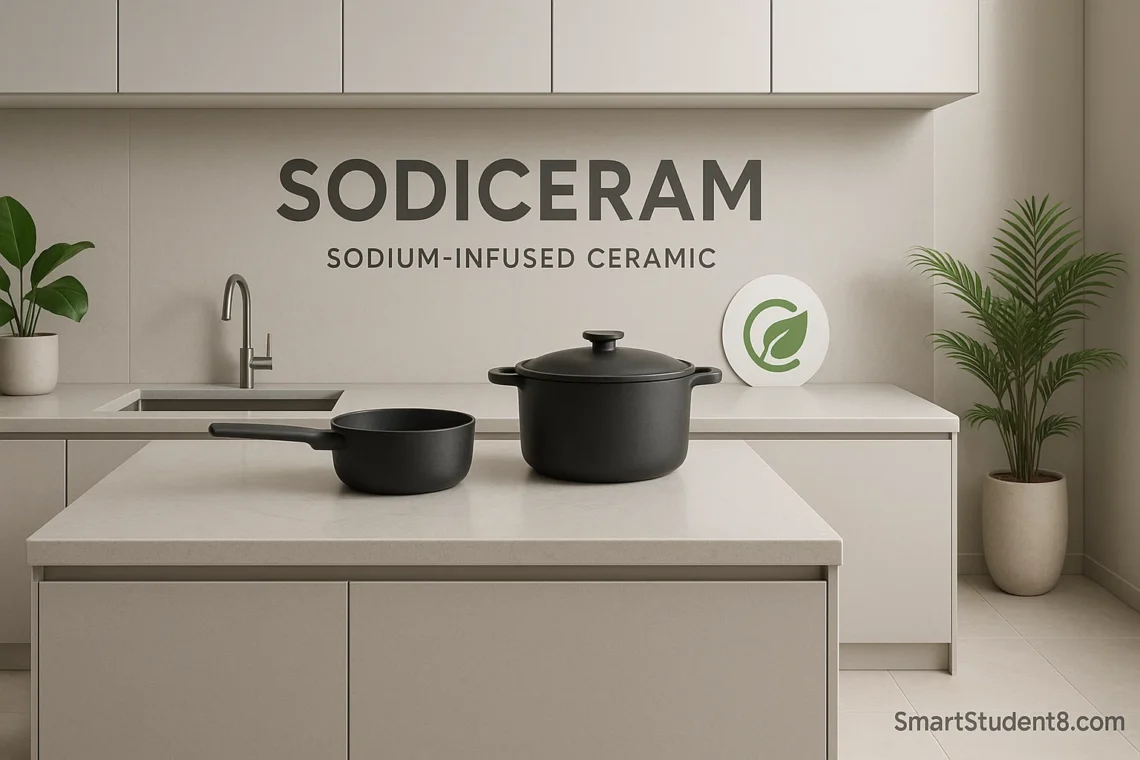In the field of materials sciences, you will find that every once in a while, there is an innovation which can change everything. The material isn’t just improved; the whole concept of a product has been re-imagined. Sodiceram – an innovative sodium-infused porcelain – is poised to revolutionize everything from kitchen countertops to hi-tech industrial uses. I’ve been interested in the history of materials and construction for many years. But Sodiceram feels different. Not just an upgrade in performance, but a shift that fundamentally changes the way ceramics are perceived.
It combines ceramic expertise with the latest chemical technology. Sodiceram’s unique properties are achieved through the infusion of a sodium-based compound during its production. Imagine floor tiles and cookware that can resist thermal shock, from freezer to oven. Industrial components and appliances that work flawlessly even under high heat and pressure. Sodiceram has made this a reality. The comprehensive guide explores the science behind Sodiceram, as well as its practical applications and sustainability.
The Science Behind Sodiceram – What makes it different?
In order to truly understand Sodiceram’s properties, it is necessary to examine the atomic level. Clay, feldspar and silica are used to make traditional ceramics, which is then heated at high temperature. It is then fired at high temperatures, creating a material which becomes hard and fragile. Although it is very strong, thermal shock, chips, and cracks can cause the material to break. While renovating my very first kitchen, I can remember being crushed when an expensive and beautiful ceramic bowl broke because I filled it with hot soup too fast. Ceramics are limited by their inherent nature.
Sodiceram transforms the process of firing by adding sodium compounds before heating. In the process of vitrification at high temperatures (which is the transformation into glass), sodium ions become part of the ceramic’s structure. The sodium ions are not just applied on the surface; they undergo a complete transformation. The ions of sodium create atomic bonds that are stronger and more flexible, which changes the fundamental properties of the material. It creates a denser, less porous ceramic which is much more resistant to heat and impact. By reinforcing material from the inside, Sodiceram adds resilience to its DNA. This results in a superior product.
Sodiceram Manufacturing Process Unpacking
Sodiceram is the result of a marriage between precision engineering and artistry. To begin, the process starts with selecting raw materials of exceptional quality. It includes clays of fine grade, minerals and specific sodium compounds which give it its distinctive characteristics. The exact measurements and proportions of these ingredients is required to achieve consistency in the final product. The ceramic’s integrity could be compromised if this step is not done correctly.
The mixture can be shaped into any desired form, such as a tile or a cookware piece. Various methods, such as pressing or extrusion, can be used to achieve this. Fire is where the magic really happens. The pieces of metal are then placed into a kiln to be heated at extremely high temperatures. This intense heat is when the sodium is infused. These sodium compounds permeate and melt the clay to create a stronger matrix. It is important to carefully manage the firing schedule so that sodium can be integrated perfectly. It is a more efficient process than traditional manufacturing methods and aligns with current demands on sustainable production.
Sodiceram’s strength and durability re-examined
Sodiceram has an exceptional level of durability. This is not an incremental upgrade; this is a major leap. Sodiceram, which is made from a sodium-infused ceramic, has a more dense, cohesive structure. This makes it more resistant to failures common in traditional ceramics. This ceramic has a superior resistance to chips and cracks from everyday impact. Consider a kitchen in a restaurant, where dishes are stacked and dropped constantly. Sodiceram can resist this abuse much better than their traditional counterparts. This leads to lower replacement cost and a more long-term investment.
Thermal shock resistance of Sodiceram is also remarkable. Sodiceram dishes can be removed from the hot oven without fear and put on a cool counter top. The new cookware offers greater convenience and better performance. This non-porous coating makes the surface highly resistant to staining and corrosion. Sodiceram is resistant to spills, such as coffee, red wine or other harsh chemicals that might permanently stain traditional ceramic surfaces or natural stones. The combination of its physical strength, thermal resistance and chemical resistance make it one of the strongest ceramics on the market today.
Sodiceram vs. The Head-to-Head comparison of traditional ceramics
Although both ceramics are considered to be the same material, they have very different characteristics. In my experience specifying materials in various architectural and interior design projects, a direct comparative analysis often clarifies the client’s choice. Sodiceram is able to compete in virtually all categories due to its advanced composition. The traditional ceramics we have used for hundreds of years are no longer able to meet the demands placed on them by modern performance and durability.
Below is a chart that breaks down key differences.
| The Feature | Sodiceram | The Traditional Ceramics |
|---|---|---|
| Durability | The dense sodium-infused structure provides a high degree of resistance to cracking, chipping and abrasion. | Under physical pressure, the material is more fragile and susceptible to breaking and chipping. |
| Thermo-Shock Resistant | Excellent. The material can handle rapid temperature variations without cracking. | Low to moderate. When exposed to rapid temperature fluctuations, the material is susceptible to cracking. |
| Phosity | Virtually porous. Highly resistant to bacteria, moisture and stains. | Unglazed versions are porous and susceptible to staining. |
| Maintenance | Low Maintenance. Cleaning is easy with household cleaners. No sealing required. | Needs to be maintained more carefully. Porous types require sealing regularly to avoid staining. |
| The Aesthetic Versatility | Color options are vibrant, consistent and sleek. The material can be matched to natural materials. | It is not uncommon for aesthetics to be limited. Glazes will wear down over time. |
| Recycled materials and more energy-efficient production methods are used to reduce the impact on the environment. | Mining of raw materials and production are typically both energy-intensive. | |
| Ceramics can be made lighter, but still strong. | The installation is labor intensive because they are heavier and cumbersome. |
It is evident from this comparison that, while ceramics of traditional types have their uses, Sodiceram, the newer, more durable, high-performance material, offers superior value and low-maintenance.
Sodiceram’s role in sustainable building and design
Sodiceram, a material that is truly environmentally friendly in an era when sustainability is not just a buzzword anymore but rather a necessity. Traditional ceramics is notorious for high energy use and a large carbon footprint. These issues are being actively addressed by Sodiceram. Production processes are often energy efficient, and some brands recycle water and reuse it, reducing consumption.
A durable material like Sodiceram is also a key factor in its environmental profile. Material that is durable will require less replacement. This reduces waste, energy and raw material consumption. When I worked on green construction projects, durable materials such as Sodiceram were used to help us reach higher certification levels. Sustainability is built on its longevity. Some Sodiceram items are manufactured with recycled materials to further improve their environmental credentials. By selecting these innovative ceramics materials, consumers, architects and designers can choose to make an environmentally-friendly choice without compromising style or performance.
Sodiceram’s Real-World Impact:
Sodiceram is a versatile material that can be found in many different applications. From our homes to industrial facilities, it has a variety of uses. Residentially, Sodiceram is a favorite for bathroom and kitchen tiles, as well as flooring. The combination of its high-end appearance and invincibility makes it a popular choice for homeowners. Imagine a countertop that has the look of marble and is resistant to staining from red wine, lemon juice or other liquids. Sodiceram makes that promise.
The durability of Sodiceram makes it the perfect choice for areas with high traffic. Sodiceram wall and floor cladding is widely used by airports and hotels. It can be easily maintained and is resistant to constant wear and tear. It was amazing to see a lobby with Sodiceram large-format tiles installed five years ago that still looked brand new. Other than architecture, Sodiceram is used:
- High performance cookware: Designing pots, pans and pans which offer superior heating distribution and are able to handle temperature extremes.
- In electronic devices, is used as an electrical and thermal insulator.
- Automotive and Aerospace for components which need to be durable and lightweight, yet able to resist high temperatures and harsh environments.
Sodiceram is a future-oriented material. As the research advances, its applications list will grow.
Common Myths and Misconceptions Regarding Sodium Infused Ceramics
It’s not uncommon for new technologies to be met with doubt and misinformation. A common concern about “sodium”, a chemical found in some household items, is its safety. You should know that sodium is chemically attached to the inert ceramic structure. This is a safe product for use on all surfaces, such as cookware or food preparation surfaces. It doesn’t leach. Sodiceram has undergone rigorous testing in order to meet the international safety and health standards.
One more misconception is that a material so advanced must be expensive. Although the cost of Sodiceram is higher initially than other low-end ceramics, it has a much greater value in the long run. In the long run, Sodiceram is more cost-effective than other ceramics because of its resistance to damages, longevity and ease of maintenance. This is not just about buying tiles or countertops; it’s also an investment that you won’t have to replace or repair for many, many years. My clients are always encouraged to view the total cost of ownership from this perspective.
Design Freedom: the Aesthetic Possibility of Sodiceram
Sodiceram’s design versatility is unmatched. The advanced manufacturing processes allow for a wide range of color, pattern, and finish options. This material is able to replicate natural materials, such as wood and marble, without the inherent disadvantages. If you want the luxury look of Calacatta for your bathroom, then you can use a material which is non-porous, will not stain, and does not require sealant.
Large-format slabs can be produced, allowing for seamless installation and minimal grout lines. It creates an expansive, clean look. The large slabs I used on feature walls and counters create a stunning, yet practical monolithic look. Sodiceram’s range includes matte, high-gloss finishes and textures.
Read More: How Much Does Water Heater Installation Cost in NJ (New Jersey)?
Sodiceram Technology – The Future Direction
Sodiceram has a long way to go. The goal of ongoing research and development is to improve its performance. Scientists have been exploring different formulations in order to improve its properties. For example, increasing the strength-toweight ratio of its surfaces or developing self cleaning surfaces. A strong focus is being placed on making manufacturing processes even more sustainable. This includes using only renewable energy, and producing zero waste.
In the near future, “smart Sodiceram” tiles may be available that incorporate technology such as sensors to detect leaks or embedded heating for floors. It is possible that this material will play an important role in creating smart homes and cities. Sodiceram, a company that specializes in eco-friendly, high-performance, reliable materials for industries ranging from construction to health care, is well positioned to fulfill these needs. The company’s success is an example of the power of innovation to transform a material that has been around for centuries into something new and extraordinary.
Sodiceram, in conclusion, is more than just another choice on the market. It represents a standard. The integration of sodium at the molecular scale allows for a new level of sustainability, durability and beauty. Sodiceram, from my professional perspective of dealing with materials on a daily basis, solves many problems that we had accepted in the past as being unavoidable. The future is brighter, more beautiful, and more environmentally friendly. It’s clear that this remarkable material signals the arrival of a new generation in ceramics.





